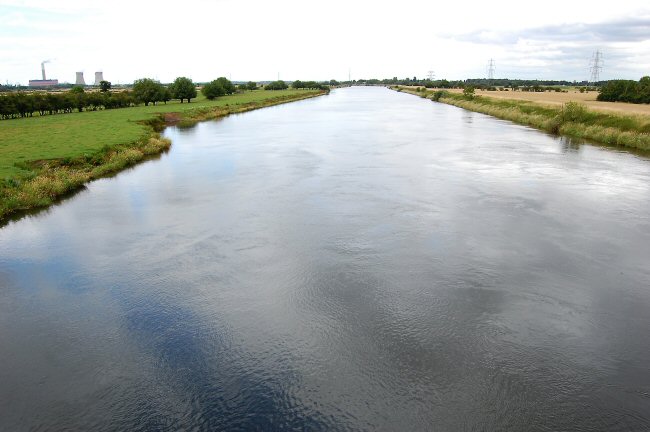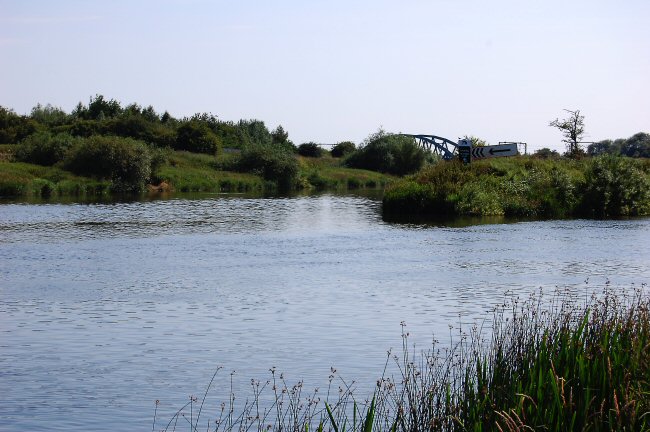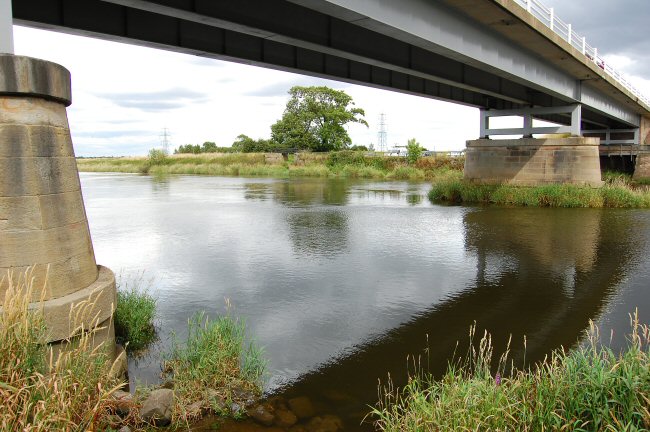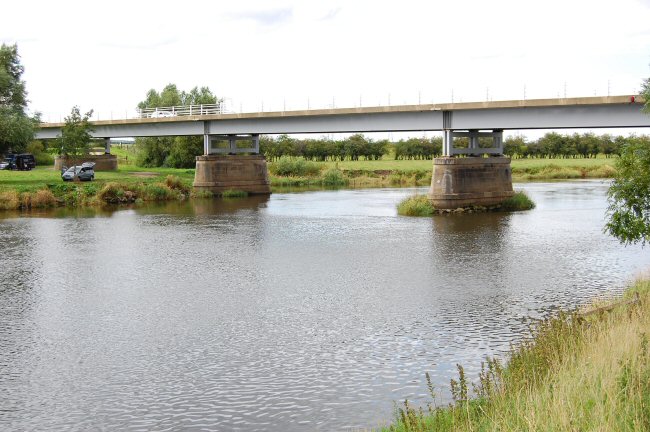The
idiot's guide to carp fishing in rivers - part 1
Quite
a few years have passed since I first put together this account of my early
forays into river carp fising. I first started fishing the Trent in 1993,
after hearing about multiple catures, often in daylight, although a year was
to pass before I had any success. Barbel were still quite a rarity at that
time, but have now completely taken over to the extent that it is now almost
impossible to get through to the carp.
Back then, I had been reasonablye successful with the local stillwater carp,
but quite honestly, I was getting bored with it all and needed a new challenge.
This is the story of a personal journey that begins in frustration and ends
in madness.
Come on then, admit it, how many of you are becoming bored and dejected with queuing up for the going swim on a weed-choked carp pool, casting your baits to the points labelled as A, B and C in the diagram, then awaiting your turn to catch Doris, Boris, Gutbucket, or these days, Henri or Jacques? You know the routine; out with the marker float onto the gravel bar near the island, spod out the hemp and pellets, then lie back and doze behind the geometrically aligned rods, kidding yourself that you are performing an intellectual exercise of great worth and magnitude. The reality is that you have blown your pay packet on a shed load of high-tech engineering, all in an attempt to assert your cognitive dominance over primitive creatures with brains less than half the size of a shrivelled maple pea.
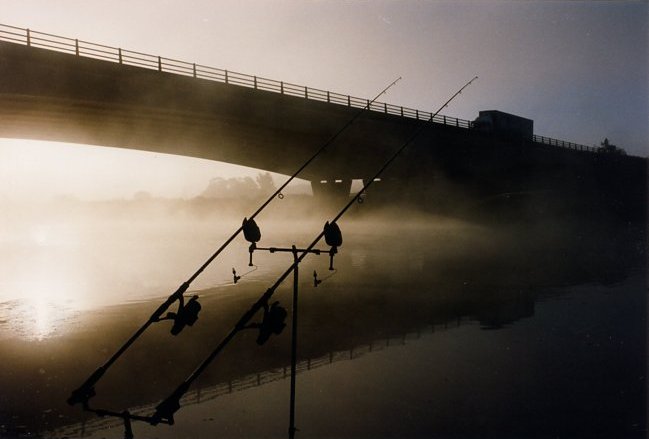
The River Trent at South Muskham - formerly a happy hunting ground for
carp, when barbel were still a rarity
I wonder how many newcomers to carp fishing regard the terms upstream and downstream as alien concepts? Well get this, I fish places where the water not only goes from side to side, it goes up and down as well! How do you locate your quarry in such a water that might be over fifty miles long? How do you fancy some real fishing, where it is necessary to be constantly alert, and sometimes even sober, and where you quite often have to re-cast every twenty minutes? For the two readers still remaining at this point, some of these questions might possibly be answered if you follow this account of how I took my first plunge into this much overlooked branch of the sport, therefore escaping the clocking on syndrome and the mechanical drudgery of still water camping, (sorry, carping). This article will not supply you with all the answers, but it should help you to avoid some of the pitfalls that can trap the unwary novice. Beware fair reader, for this material is not suitable for those of faint heart or nervous disposition!
Here be monsters - the tidal Trent, a river that goes up and down as
well as backwards and forwards
Now I know the introduction
to this piece might have lead you to believe it is all about fishing in tidal
waters, but that was just to titillate you and for dramatic effect. I once
read a book entitled Fishing For Londoners, which in spite of its title, was
all about catching fish. As I began to write this piece, I started to realise
that it was turning into more of an epic adventure story of the trials and
tribulations over the best part of a decade, on both tidal and non-tidal stretches.
I would have liked to have called it Up And Down The Crazy River, but Paul
Boote and Jeremy Wade beat me to it.
It all began at the beginning of the Nineties, when I came across an article
by Chris Ball, describing the time when Nick Forward took him for a day’s
carp fishing on the middle Trent. Yes, you did read that correctly, and not
only was it in the daytime, it was also in bright sunshine! Not only that,
they caught stacks of carp, heaps of chub, and a carrier bag. This really
appealed to me. The local waters had all gone to sleep and I had two week’s
holiday coming up. Perhaps, for just once in my life, I might be able to go
back to work with a healthy suntan instead of creeping back in my usual state
– deathly pale, sickly and mad eyed, like someone who had spent the last two
weeks hanging upside down in an attic in Transylvania.
I had never travelled very far for my fishing at this time, as I had a number of reasonable waters within easy travelling distance. Just as well, as I had never owned a car that I trusted to take me further than the fifteen miles or so to Peterborough without breaking down. That distance allowed me to arrive at the water in clouds of steam, but still be able to make the return journey after re-filling the radiator with lake water. The Trent, although a doorstep water by many peoples’ standards, was more like a trip to the Amazonian rainforests by mine and a prospect that filled me with dread. Travelling to fish an unseen water can often be a bit daunting. It’s all very well scanning the Ordnance Survey maps, but they can’t really tell you the true nature of the water. Be warned; one venue I chanced for the first time appeared on the map to be a side-stream entering the river on a wide, sweeping bend. In reality it was an oily land drain trickling into the river through a concrete culvert. The river Trent at this point was set in a featureless waste land and at low tide, it raced fiercely through lethal, wide corridors of stinking, black mud.
The nearest stretch of the Trent to my home, as the cormorant flies, is where the A52 meets the river at Gunthorpe. Studying the map, I liked the look of a dramatic bend at Radcliffe, but when I tried to get there, the road that seemed to go right up to the river actually ended in a cul-de-sac, with no obvious way of getting to the water. Moving downstream to Stoke Bardolph, I found it fully booked up for matches. The same was true at Shelford and East Bridgeford. Every car park had the notices displayed, “Beware, thieves operate in this area”. A warning about the bloody matchmen might have been more appropriate. By now it was well past mid-day, so I walked downstream with an air of despair and resignation until I found a vacant run that nobody wanted in about three feet of fast flowing water. I was not a happy bunny. Adding to my anger over this monopolising of mile after mile of river was the phenomenal amount of litter.
It really had to be seen to be believed. There were beer cans, sweetcorn cans, jagged luncheon meat tins, plastic bags full of rotting casters, all crunching and squelching beneath my feet with every step. After an hour of watching my rod tips keel over under the weight of the accumulated weed and crap that built up on my lines every few minutes, I packed up in disgust and decided on a last ditch attempt to investigate the area around Gunthorpe bridge. Someone was just leaving a promising looking swim just upstream of the bridge which had the benefit of what I thought was a carpy looking slack near one of the supports. I spent an hour idly flicking boilies to the rats until I lost my entire stock of leads in the multitude of snags. As I was packing up, a young lad who came over to try to scrounge some maggots helpfully informed me that he had never seen anybody fishing here for carp before. “You don’t want to fish here mate, you want to try Crankley Point, it’s brilliant”, but when I tried to get him to point it out on my map, but he seemed to be struggling. I later found out that the A1 Pits that he was searching for as a reference point didn’t even exist when my map was printed, but I filed it away inside my head for future reference. Score so far - Carp one, Pete nil.
Found at last - Crankley Point, where the twenty most heavily fished pegs on the Trent are upstream to the right
During the week, I dug out my huge stack of fishing magazines and began poring through them for any references to river carp, and especially the Trent. Then, while flicking through the latest Carpworld, my eyes caught a little snippet in the Black Lizard section about pioneering anglers experiencing up to thirty runs a night from the tidal Trent in the Dunham area, with unsubstantiated rumours of a thirty. So, Dunham it was then, and the following Friday morning found me approaching the bridge bright and early to continue my quest. Not having a clue where to go, I pulled out of the queue for the toll booth and followed the route being taken by a tackle laden car along a bumpy track at the side of the bridge. The car was nowhere to be seen, but in front of me was what appeared to be a near vertical earth bank marked by wheel ruts. Now I know I’m a fen lad, and a speed bump is the closest I normally get to a hill, but there was no way I was going over that. I walked up to it and peered at it for a minute or two, mentally assessing the angle of approach necessary, and also noting the warning piles of splintered metal and mudflaps. By now there was another car behind me, and there wasn’t enough room to turn round or let it pass, so gingerly, I put the car into first gear and tried to steel my nerve. I couldn’t make my mind whether to ease the car over it gently, and risk being grounded, or to put my foot down in an attempt to fly over it, Steve McQueen style. I opted for the first option, sliding almost sideways down the other side, only to stop in front of a notice board informing me that there was a match along the entire stretch. Don’t these blokes ever do any work? After driving along the entire length of the earth bank without finding the secret exit, I went back the same way, carving a paint lined groove into the soil with my newly cracked spoiler.
Dunham Bridge - I fished downstream to the left, casting into the submerged junkyard around the central pillar
It seems that to cross
from Lincolnshire into Nottinghamshire it is necessary to pay some kind of
special tax, and there were border guards on the bridge to enforce it. Once
on the other side, I drove down to the bottom of the bank, only to be greeted
by the dreaded notice informing me that there would be a match on. Bloody
Thatcher, if she hadn’t closed all the pits I might have been able to get
a bit of river to myself. On the bright side however, the last peg stopped
just short of the bridge, leaving me with a nice shot at a slack behind a
bridge pillar in mid-river. Then I read the sign that said all tickets must
be bought in advance.
After a short excursion into Dunham village, I arrived back under the bridge
to see the match anglers fanning out along the river, with one of them heading
ominously in my direction. “You can’t fish here mate, it’s pegged up for t’match”.
I was getting just a little bit distraught at this point. After all, hadn’t
I taken to the rivers to escape all the swim hogging? Expanding my chest to
square up to this bullet headed tub of lard, I subtly pointed out that the
last peg number upstream of the bridge clearly corresponded to the last number
designated on the notice board. This complex mental calculation clearly threw
him, so he grunted some sort of threat in flattened vowels which I interpreted
as being something involving the steward, and flapped off up the bank in his
waders. Now the steward, when he arrived, far from being Robocop crossed with
The Terminator, was actually quite calm and apologetic and explained that
a collapse of the bank had made one of the booked pegs unfishable, and would
I mind if the gentleman fished about fifteen yards upstream of me. Tolerant
and reasonable to the last, I answered that I would be quite happy to accommodate
a fellow angler in time of need, and proceeded to set my gear up. I later
found out that the bit under the bridge was River Authority owned, so not
only was it not available for match pegging, but I also needn’t have bought
a day ticket.
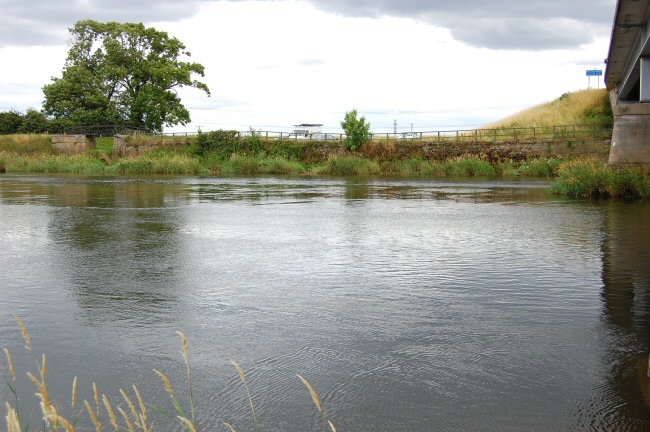
Turning back to the task in hand, I was faced with a bit of a problem. Surveying my domain, I had a slack area of shallow, muddy water immediately downstream, divided from the main river by a line of half submerged wooden posts which jutted out of the water at five foot intervals. Immediately in front of me were rocky shallows beyond which the main river flowed swift and turbulent. Out behind the centre pillar, the small slack appeared to give the only realistic chance of a fish. I took out my longest bankstick, as it was obvious that I would need to keep as much line out of the main current as possible, but no matter where I tried I found it impossible to penetrate the solid bedrock. The answer to this was to construct two impressive looking pyramids of boulders to encase the front and rear rests. Out went the first cast, and within seconds the whole arrangement was whipped round by the current and started to keel over. Undeterred, and using the spare bit of my brain reserved for special occasions, I re-assembled the pyramids, but this time I lashed two shorter banksticks to the front one, using most of a roll of insulating tape, thus forming a sort of tripod. This more or less did the trick, and eventually I had two baits out in the centre slack. All this achieved in less than an hour.
[Sorry, I wanted to add a close-up of the improvised tripod here, but I can't find any way of getting Dreamweaver to align more than a single line of text alongside the photo]
I felt quite pleased with myself when it seemed that this arrangement seemed to be working, and that my three ounce leads were holding firm. As Dr. McCoy almost certainly never said, “It’s carping Jim, but not as we know it”. Even when the weed started to build up on the line, still those leads held firm. Even when I realised that something wasn’t quite as it should be and attempted to reel in, those leads still held firm. They would do really, as they must have been snagged solid from the moment they hit the bottom. It’s amazing how much effort it takes to break 12lb line isn’t it? I fished through my rucksack and in desperation, attached a 4oz ball lead that I had prised out of the mud somewhere. Perhaps I should explain that at this time, when anyone talked about using heavy leads, they usually meant something in the region of 2 ounces. Anything heavier was considered more suitable for propelling a bunch of black lugworm out beyond the third breaker.
I lobbed this out, hoping
the rod wouldn’t splinter, and fished the other in the slack, more for show
than anything. Within minutes I had what seemed to be a whiting bite on the
bait out in the middle. I struck, something kicked back, moved upstream, then
fell off. By the time I had re-baited, I had another little problem on my
hands. The water had risen so rapidly over the shallows that I could no longer
get to my rod rests without wading. I had just discovered yet another of the
joys of fishing tidal rivers. I didn’t know how long it would be before the
tide went out again, but I guessed it might be more than a few minutes so
I tip-toed out into the river, and just managed to recover everything before
the Trent water inflicted irreversible damage on my dangly bits. I just lobbed
the baits into the nearby shallow slack, propped my rods up on my rucksack,
retreated onto a lumpy rock, then hid my head between my knees behind a pillar.
At that moment the heavens opened up, and within minutes, a stream of cold
water came pouring through one of the bridge’s drain holes; right down my
neck. I just knew that my unwanted neighbour would probably be rolling around
on his seatbox in hysterics and I had no wish to make eye contact.
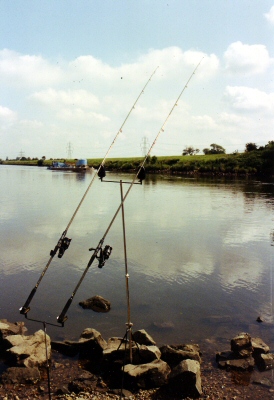 ..............
.............. 
Left: Improvisation at its worst - and it didn't even work........... Right: Mick Lomas
Just as I was about to pack up, John Hurt appeared. “I could see you as I was walking along the bank, and realised that here was another madman involved in this futile pursuit”. I was just about to tell him how much I enjoyed his performance in The Hit, and to enquire whether Terence Stamp was also a fellow angler, when he introduced himself as Mick Lomas. He couldn’t fool me though, I know how these stars like to retain a bit of privacy. He made me feel slightly less suicidal by explaining that this was indeed a difficult swim to fish and that I might have more success if I tried an area further upstream. He then gestured into the distance and gave me some complicated directions to some kind of an eddy, that I forgot instantly and which seemed to require an intimate familiarity with the taxonomy of trees. I was cheered up enormously. I now had vague directions to a swim that really did hold carp, or at least had done at some time in the past ... and I was now on holiday.
